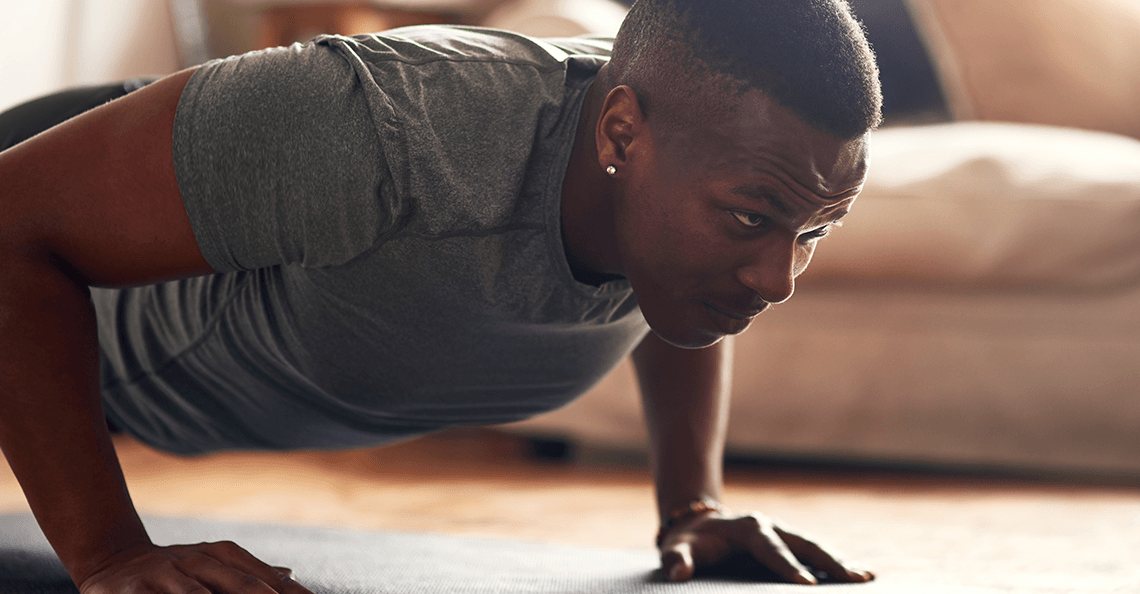When the coronavirus hit and gyms closed down, those of us who train athletes and other advanced clients faced what seemed like an impossible challenge: helping them achieve high-performance goals when they’re at home with limited equipment.
This isn’t theoretical for me. As a strength and conditioning coach for Rugby Canada, I train athletes who were in the weight room four times a week, with programs that included Olympic lifts and heavy squats. Now they’re at home with the same needs but nothing to lift beyond their own body weight.
It’s not the first time I’ve faced this challenge. I used to work with members of elite military units whose deployments left them hundreds of miles from the nearest gym. The bodyweight exercises and techniques I used helped them achieve their goals despite their environment.
Here’s what I learned about training clients for high performance without the usual tools of our trade—starting with what not to do.
The home workout mistake you must avoid
Progressive overload is the key to everything we do as trainers. It doesn’t matter if the client is a deconditioned beginner or an elite athlete. To make that client stronger, we manipulate variables like load, volume, frequency, and duration.
But when we can’t easily change the load with barbells and dumbbells, we focus on volume. We have our clients do too many reps of too few exercises, setting them up for overuse injuries.
Worst-case scenario: After doing high-rep sets of push-ups and lunges three or four times a week, your most enthusiastic clients end up with shoulder impingement and patellar tendonitis.
You’d never train a client like that in the gym. Why would you do it at home?
So let’s talk about how you can help your clients get the results they want without unnecessary injury risks.
We’ll start with what I call the three Ls: load, levers, and limbs.
Home workout fix #1: Load
Everyone has a backpack. And everyone has things they can put into the backpack to create a load—canned goods in the kitchen, books in the living room, maybe a few bricks or paver stones out on the porch.
If the client has kids, or an unfinished home-improvement project, they may even have a sandbag, a sack of cement, or a couple of paint cans. If they have pets, they probably have a large quantity of dog or cat food.
What do those inanimate objects have in common? They all give your clients heavy things to lift.
Anything you can do with a sandbag or weight vest in the gym, your clients can do with a backpack filled with odds and ends. Old milk jugs filled with water or sand can substitute for dumbbells or kettlebells on some exercises.
APPLICATIONS
Push-up variations (wearing a loaded backpack):
Bent-over row (holding the straps of the backpack):
Chops and other core exercises (holding the sides of the backpack):
Other options:
- Squat variations (wearing a loaded backpack or holding the load against the chest)
- Deadlift variations (holding the straps of the backpack)
- Overhead press (lifting the backpack with one or both hands)
- Single-joint exercises (lifting the backpack with both hands, or a can, bottle, or jug with one hand)
Home workout fix #2: Levers
Consider the inverted row, an exercise we all know how to do at home. Take a broomstick, balance it between two chairs, and you’ve got the functional equivalent of a Smith machine.
We also have an illustration of how levers work: To make the exercise easier, shorten the lever by moving the feet closer to the body. To make it harder, lengthen the lever by moving the feet farther away.
We can even lighten the resistance in the middle of a set by changing foot position, as shown here by Kellie Davis:
Another way to increase the challenge: Do a slow eccentric contraction with a long lever, and then bring your feet up to make it easier for the concentric portion.
Push-up variations give us even better examples. Consider this progression from easiest to hardest:
- Wall push-up
- Countertop push-up
- Hands-on-couch push-up
- Kneeling push-up
- Traditional push-up
- Feet-elevated push-up
- Pike push-up with feet on chair
- Handstand push-up
In most of them, you’re making the movement more challenging by forcing your body to move a higher percentage of your body weight. Then, with the final three, you’re changing the angle to force smaller muscles in your shoulders to take on more of the load.
You can also combine a slow eccentric contraction in one variation (like the traditional push-up) with an easier variation for the concentric portion (like the kneeling push-up).
Home workout fix #3: Limbs
The same load becomes much heavier when you reduce the number of limbs involved in lifting it. It’s perhaps the simplest and most intuitive way to increase intensity.
As an added bonus, working with one limb at a time doubles the number of reps per set, which is an easy way to increase the density of the workout.
APPLICATIONS
Lunge and split squat variations (wearing a loaded backpack or holding the load against the chest):
Romanian deadlift variations (wearing a loaded backpack or holding the load against the chest):
Sprinter calf raise (using body weight or wearing a loaded backpack):
Other options:
- Single-arm push-up variations (using a wall or elevated surface for most clients)
- Single-leg glute raises and hip thrusts (using body weight or holding something heavy on the working side)
Home workout fix #4: Sliding exercises
Sliding exercises provide a unique training stimulus because they require constant engagement of hip and trunk muscles throughout the range of motion.
If you train athletes, you’ve probably used a slide board, and many of us have also used Valslides or some other type of sliding discs. At home, a towel works just as well on a tile or wood floor.
APPLICATIONS
Towel hamstring curl:
Towel single-arm push-up (with the arm sliding forward, to the side, or alternating between the two movements):
Other options:
- Towel pec fly push-up
- Towel side or reverse lunge
- Towel knee tuck
- Towel mountain climber
- Towel body saw
Home workout fix #5: Plyometrics
Because plyometrics are intense and short, with long rest periods between sets, we rarely include them in programs for clients focused on hypertrophy or fat loss. The risk seems out of proportion to any potential progress toward the clients’ goals.
But when used cautiously, plyometrics can be a great way to increase both the intensity and variety in a home workout program for a client who has little to no equipment. That’s in addition to the neuromuscular benefit of learning to coordinate fast, powerful movements involving the body’s largest muscles.
Guidelines
- Do plyometrics early in the workout, after the warmup and before the first strength exercises.
- Do one plyometric movement per workout, or at most one each for upper and lower body.
- Do a maximum of five reps per set and no more than four sets.
- Recover for two to three minutes between sets. (Clients can do mobility or core exercises in between sets, as long as they don’t fatigue the same muscles.)
- Start conservatively and progress slowly. Don’t throw your 50-year-old executive right into a pro athlete’s routine, no matter how cool it looks on Instagram. (And for that matter, don’t throw an athlete into that routine unless they’re ready for it.)
Progression
You can start any client with the double-leg drop. Emphasize how important it is to “stick” the landing, even though they haven’t actually left the ground:
You can progress to landing from a low step, countermovement jumps, and broad jumps. That should be challenging enough for most nonathletic clients.
Upper-body plyometrics
Most plyometric push-ups are variations on the same idea: Lower the body under control, then push off the ground explosively. There’s no need to do a hand clap at the top—or, for that matter, to even lift the hands off the floor. The benefit comes from the speed of the movement, not the distance.
You can also use single-arm variations, like the wall push-away:
Use these exercises with caution, especially if the workout includes traditional push-up variations. No matter how eager your clients are to get their work in, their shoulders can only take so much repetitive stress.
Putting together a high-performance home workout
I’ve had great results with EMOM (every minute on the minute) workouts, both for my clients and in my own training.
The following workout takes 30 minutes for five rounds. Three of the exercises require a loaded backpack, using the same weight for all three.
Minute 1: Backpack alternating reverse lunge for 30 seconds
Minute 2: Backpack squat to press for 30 seconds
Minute 3: Backpack biceps curl for 30 seconds
Minute 4: Hamstring walkout for 30 seconds
Minute 5: Front plank for maximum time, up to 60 seconds
Minute 6: Rest
Use the first round as a warmup, working without weight on the reverse lunge, and doing fewer reps or working for less time on the others.
Final thoughts on home workouts for athletes and advanced clients
With the options I’ve shown here, you have lots of ways for your clients to make progress while training at home with little to no equipment. You can mix and match these exercises in countless ways for endless variety.
But the trick, as you know, isn’t coming up with the ideal exercise order and set-rep scheme. That’s the fun part. The challenge is making sure …
- Your clients want to start the training session.
- They’re willing to work at a high enough effort to get the results they want.
- They can do the workout without risking their most vulnerable joints because of excessive volume.
If you can do all that, you know you’re earning your pay.











